|
|
|
Sort Order |
|
|
|
Items / Page
|
|
|
|
|
|
|
| Srl | Item |
| 1 |
ID:
132949
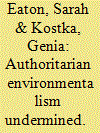

|
|
|
|
|
| Publication |
2014.
|
| Summary/Abstract |
China's national leaders see restructuring and diversification away from resource-based, energy intensive industries as central goals in the coming years. On the basis of extensive fieldwork in China between 2010 and 2012, we suggest that the high turnover of leading cadres at the local level may hinder state-led greening growth initiatives. Frequent cadre turnover is intended primarily to keep local Party secretaries and mayors on the move in order to promote the implementation of central directives. While rotation does seem to aid implementation by reducing coordination problems, there are also significant downsides to local leaders changing office every three to four years. Officials with short time horizons are likely to choose the path of least resistance in selecting quick, low-quality approaches to the implementation of environmental policies. We conclude that the perverse effects of local officials' short time horizons give reason to doubt the more optimistic claims about the advantages of China's model of environmental authoritarianism.
|
|
|
|
|
|
|
|
|
|
|
|
|
|
|
|
| 2 |
ID:
134309
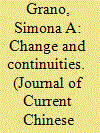

|
|
|
|
|
| Summary/Abstract |
In representative governments, a healthy turnover of power among ruling parties is viewed as a critical sign of democratic principles. In a political environment where voters’ opinion is the key political driver, the greatest challenge facing the NGO community is often that environmental concerns only represent secondary aspects of the policy-making process. This article focuses on the transformations (or lack thereof) in Taiwan’s environmental governance, under different political parties, particularly during the past few years. I begin with an overview of the key issues that have characterised Taiwan’s environmental movement and its battles, starting with the democratic transition of the mid-1980s, before focusing on two developmental projects – Taiwan’s eighth petrochemical plant and fourth nuclear power facility – to bring to light the most significant changes and continuities in the environmental-policy realm. I pay special attention to the post-2008 period and the ensuing renaissance experienced by the environmental movement, among others. The final section considers the consequences of the KMT’s second elect-oral victory – in January 2012 – for environmental policies and, in light of the article’s findings, summarises what has changed and what has consistently remained the same under different ruling parties.
|
|
|
|
|
|
|
|
|
|
|
|
|
|
|
|
| 3 |
ID:
092336
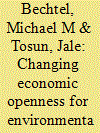

|
|
|
|
|
| Publication |
2009.
|
| Summary/Abstract |
Citizens' concerns about (international) environmental protection standards are of increasing importance to governments in industrially advanced, high-regulating countries. In almost any proposal for a trade agreement, countries with low environmental regulation standards are required to introduce higher policy standards in exchange for high-regulating countries dismantling their trade barriers and granting access to their domestic markets. Low-regulating countries often act as required and introduce legislation aimed at reducing pollution. This leads to declaratory or de jure policy convergence. But such legislative action is not always associated with de facto or actual policy convergence, since policies are not always enforced. To analyze the strategic aspect of this potential "slippage," we set up a game-theoretic model with imperfect information. In the model, a high-regulating and a low-regulating country negotiate a bilateral free trade agreement with environmental provisions. We show how potential gains from trade, policy enforcement, and reputation costs, as well as domestic demands for environmental protection affect the occurrence of environmental policy convergence through conditional trade agreements. This study thereby advances our understanding of the relationship between bilateral trade and convergence of environmental policies.
|
|
|
|
|
|
|
|
|
|
|
|
|
|
|
|
| 4 |
ID:
114780
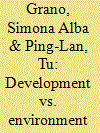

|
|
|
|
|
| Publication |
2012.
|
| Summary/Abstract |
This article presents a case study dealing with the controversy surrounding the construction of an alternative road connecting Danshui with Taibei City. The study serves to elucidate what the key influences are that govern environmental power dynamics between different agents in Taiwan and how these multiple levels of interaction are negotiated by the various players. The authors argue that although environmental policies are, for the most part, mandated from the top, at the local level their implementation can be bypassed, altered or stalled by these various agents.
|
|
|
|
|
|
|
|
|
|
|
|
|
|
|
|
| 5 |
ID:
132636


|
|
|
|
|
| Publication |
2014.
|
| Summary/Abstract |
In recent years, sustainability has represented one of the most important policy goals explored in the environmental Kuznets curve (EKC) literature. But related hypotheses, performance measures and results continue to present a challenge. The present paper contributes to this ongoing literature by studying two different EKC specifications for 10 Middle East and North African (MENA) countries over the period 1990-2010 using panel data methods. For the first specification, namely EKC, we show that there is an inverted U-shape relationship between environmental degradation and income; while for the second specification, namely modified EKC (MEKC), we show that there is an inverted U-shape relationship between sustainability and human development (HD). The relationships are shaped by other factors such as energy, trade, manufacture added value and the role of law. More interestingly, findings from the estimation show that EKC hypothesis, HD and sustainability are crucial to build effective environmental policies.
|
|
|
|
|
|
|
|
|
|
|
|
|
|
|
|
| 6 |
ID:
192741
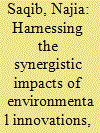

|
|
|
|
|
| Summary/Abstract |
According to the Sustainable Development Goals (SDGs), the principal threats to human well-being encompass both non-renewable and renewable energy sources, alongside a mounting environmental deficit, which aligns with the targets of SDG-7 and SDG-13. This study explores how environmental technologies, financial growth, and energy use influence the ecological footprint and green growth in the top-ten countries with the biggest ecological footprint from 1990 to 2019. Environmental innovations, green growth, and renewable energy improve the environment, while financial expansion and the use of non-renewable energy have been shown to be detrimental to the environment. Financial expansion, ecological impact, and non-renewable energy constrain green growth. However, environmental innovation and renewable energy deployment have a cumulative effect on green growth. Moreover, the results of the panel causality approach signpost a bidirectional causal association between environmental innovations, green growth, non-renewable and renewable energy, and ecological footprint. Nevertheless, it is observed that there exists a unidirectional causal relationship from financial development to ecological footprint and green growth. Moreover, this paper provides an in-depth evaluation and offers significant policy recommendations, both in a general sense and specifically targeted towards countries with the highest ecological footprints.
|
|
|
|
|
|
|
|
|
|
|
|
|
|
|
|
| 7 |
ID:
186007
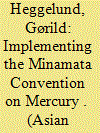

|
|
|
|
|
| Summary/Abstract |
China has undertaken a major shift in its position on mercury as an environmental problem over the last decade and a half. It ratified the Minamata Convention (MC) in 2016 and by doing so has committed to implement the treaty objectives. This article asks: How do we explain China's will and ability to implement its MC obligations? There is little systematic knowledge about the main factors underlying implementation of international mercury objectives in China, hence this article contributes new research on this important topic. We examine the implementation process, focusing on the coal sector and differentiate between indirect effects from other policies and direct efforts to implement obligations. We find that China has moved toward stricter regulation of mercury emissions and direct implementation of the Minamata Convention in the coal sector. However, our study shows that local implementation capacity needs improvement.
|
|
|
|
|
|
|
|
|
|
|
|
|
|
|
|
| 8 |
ID:
181462
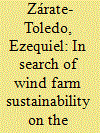

|
|
|
|
|
| Summary/Abstract |
Through the analysis of the corresponding Environmental Impact Assessment (EIA) for five wind projects set up on the Yucatan coast, in Mexico, this work seeks to draw attention to the environmental controversies that these projects generate. To carry out our analysis, we resorted to three sources of information that are part of the EIA process: (i) the Environmental Impact Statement (EIS), presented by private companies, for these wind farms; (ii) observations and criticisms of the EIS, presented by the civil society during the public process to which the EIS is submitted; and (iii) the rulings emitted by the federal environmental authorities. This documentation was complemented by participation in a number of forums and some interviews. Based on this analysis, we defined a series of deficiencies in the EIA process. Accordingly, we can affirm that in Mexico, as in other countries, there is no wind energy plan capable of reconciling energy objectives with nature conservation. Renewable energy projects in Mexico have been designed solely based on the distribution of wind or solar resources, completely ignoring environmental or social issues. In this regard, a sustainable energy transition requires strengthening the environmental management capabilities of governments, and the application of mechanisms that will allow the integration of environmental variables in the early stages of decision making, using instruments such as the Strategic Environmental Assessment.
|
|
|
|
|
|
|
|
|
|
|
|
|
|
|
|
| 9 |
ID:
132951


|
|
|
|
|
| Publication |
2014.
|
| Summary/Abstract |
China's relatively recent dramatic increase in forest area has been hailed domestically and globally as one of the world's few environmental success stories, but significant problems remain in China's reforestation efforts. We describe the challenges that China still faces if it is to meet its laudable - but sometimes contradictory - goals for its forest sector: improving rural livelihoods, sustaining and restoring ecosystem services, and increasing output of the forest product-dependent manufacturing and construction sectors. We do so while pointing out the unintended consequences of implementing these policy goals: overstatement of the quantity and quality of the forest recovery, domestic human and ecological costs of the reforestation, and externalization of China's continually growing demand for timber and forest products in the form of increased imports from vulnerable forests in other parts of the world.
|
|
|
|
|
|
|
|
|
|
|
|
|
|
|
|
| 10 |
ID:
136241


|
|
|
|
|
| Summary/Abstract |
A comprehensive review of the U.S. federal biofuel-related policies, from 1955 to 2012, was conducted to examine the progression of life cycle thinking within the policies. Over 1300 past and present federal and state biofuel laws and incentives were analyzed to identify the establishment of Life-cycle thinking (LCT) in the biofuel policies. The policies were searched for search terms representing the three themes: life cycle assessment, environmental impact and sustainability. LCT in policies was first seen in the Renewable Fuel Standard under the Energy Independence and Security Act of 2007, where life-cycle greenhouse gas emissions reduction of biofuels was required. Existing U.S. biofuel policies were also characterized to define types of policy as tax incentive, grants, mandate, etc. The results suggested that climate change or energy incentives, air quality or emissions, etc. should be more emphasized in fuel legislation for a continuous improvement of biofuels industry. Only 13% of both the federal and state policies reviewed in this study employed some aspect of LCT. Policies that incorporate LCT often only focused on greenhouse gas emissions; policies should include other environmental impacts to avoid any environmental tradeoffs and unintended consequences from biofuel production.
|
|
|
|
|
|
|
|
|
|
|
|
|
|
|
|
|
|
|
|
|